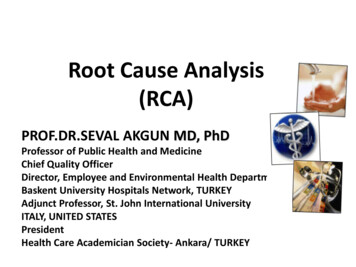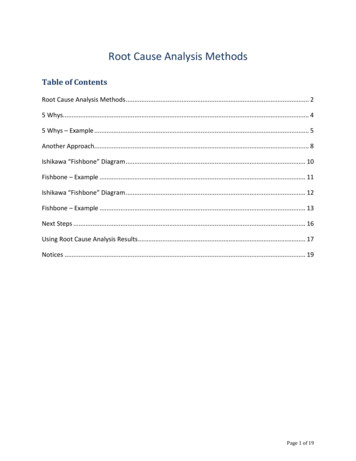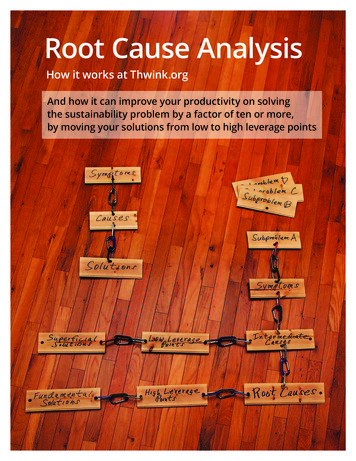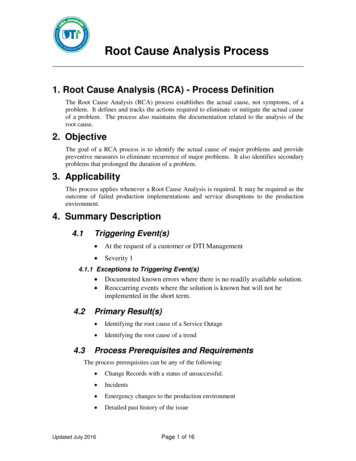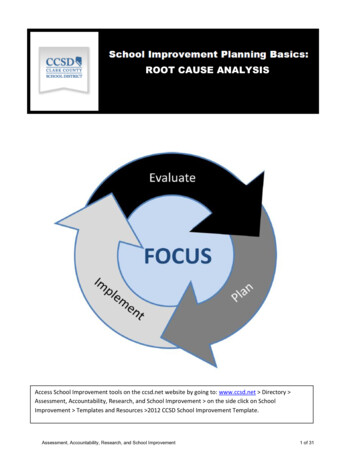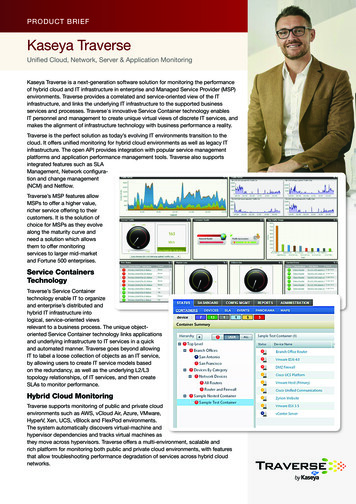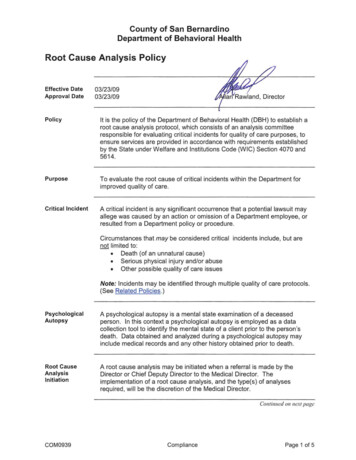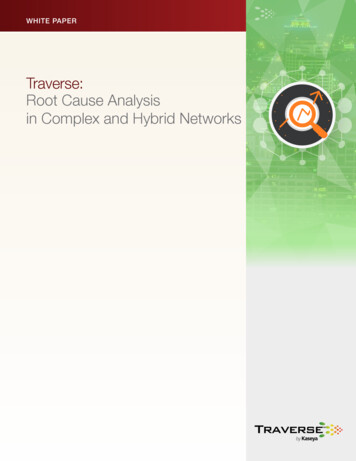
Transcription
WHITE PAPERTraverse:Root Cause Analysisin Complex and Hybrid Networks
WHITE PAPER Traverse: Root Cause Analysis in Complex and Hybrid NetworksThe job of an IT administrator is packed with daily challenges. As IT pros,they are professional problem solvers. Unfortunately, their problems neverseem to end so work days are filled with troubleshooting, which oftencomes down to network Root Cause Analysis (RCA).RCA has never been exactly easy, but when networks and IT infrastructurehad a simpler architecture, finding a root cause was not overly complex.It was usually either the LAN or the WAN, and if an application were toblame, it was installed on a non-virtualized on-premises server so huntingit down was pretty straightforward.However, those days are long gone, replaced by complex infrastructureand networks that can contain several cloud services and applications(including hybrid implementations), and virtualization—all spread overseveral offices and geo-locations.This paper will outline the major network challenges faced by today’s ITadmins, how this leads to the dreaded ‘Swivel Chair’ syndrome, causedby out-of-date network monitoring tools, and how they can break free ofthis syndrome—and conduct fast, efficient RCA and remediation.Network Complexity and the Life of an IT AdminToday, the relative simplicity of a simple LAN or WAN is a distant memory—and has beenreplaced with ever increasing complexity. How complicated have networks become? Let uscount the ways.There are still LANs, but today they often connect ‘these’ servers to ‘those’ servers, and thenfeed wireless access points through which end users get to the network.At the same time, computing is more distributed. Applications reside both in-house and in thecloud, and some applications are even hybrid where processing is shared between the two.Even more rare today is the on-premises server that is not virtualized. Virtualization turns oneserver into many and makes it more difficult to find which virtual machine is actually causingthe server problem. This complexity is only magnified when IT has to manage different servervirtualization technologies such as VMware, Microsoft Hyper-V, Zen or others.On the cloud side, most company infrastructures contain a multitude of cloud services,covering everything from public cloud services such as Amazon Web Services (AWS), tobusiness applications such as Microsoft Office 365, to scores of other services. Each cloudservice has its own dedicated form of management.On the other side of the divide, today’s critical applications serve users in multiple departments, spanning various geographic locations. Frequently, these applications either arerevenue-producing or revenue-impacting, and the business’ health is directly tied to theirperformance and availability.What IT Admins Need: Superhero VisionThe problems admins attempt to define are almost infinitely varied. Some are deal breakerswhere the network or an application is brought down entirely. Others involve slow performance—issues that can actually be harder to trace.IT has to be adept at managing and troubleshooting this complex infrastructure so that business services stay up and running—with a goal of zero or near-zero downtime. That meansholistically managing servers, applications and network devices. And not just managing, butpreemptively addressing problems before they turn into downtime.
WHITE PAPER Traverse: Root Cause Analysis in Complex and Hybrid NetworksWhat IT Admins Get: “Swivel Chair” SyndromeTraditional monitoring tools tend to operate in silos. They often focus on on-premisesnetworks, specific applications—including cloud apps, OSes, virtual servers—or bits ofnetwork gear such as routers and switches. This makes it tough to pinpoint the root causeof any single networking problem.This tangle of tools leaves IT admins staring at a bank of screens, with each displaying adifferent console. As IT staff search for problems, or try to find a solution, they shift fromconsole to console—an approach that leads to “Swivel Chair” syndrome. They turn this wayand that, in a swiveling process that is neither efficient nor holistic. In fact, it can take hours,and even days, to identify the true cause of the problem, never mind fix it.These challenges have only been deepened as IT groups adopt more and more cloudservices.The Great Cloud Management Admin ChallengeMoving applications to the cloud has been an exciting endeavor, filled with promises offlexibility, cost efficiency, and easier end-user access. Admins are happy because leveragingthe cloud relieves them of many on-premises IT admin chores. However, they soon find thatthe cloud raises a host of other admin issues that impact uptime—issues that can be vexingto repair.Ironically, the section of cloud infrastructure that is most vulnerable to downtime andperformance issues is not the public cloud services. AWS, for example, only had two anda half hours of downtime in all of 2015.In fact, the most vulnerable element in any cloud set up is the company’s own network.Managing that network is still the responsibility of a company’s IT group. Monitoring forproblems, both current and pending, requires visibility across both internal networks, aswell as any WAN or internet connections. Problems that bring a business service to a haltcan come from a number of sources—from a router or NIC issue to another networkinfrastructure component causing the issue.As we’ve mentioned, since traditional monitoring tools are often focused on on-premisesnetworks, these tools do little to monitor the public cloud. This makes it tough to pinpointthe root cause of cloud networking problems.Hybrid Cloud Impact on Monitoring, Management and RCATo make matters worse, the talk today isn’t just about public clouds but also includes hybridclouds, which combine private and public clouds into one unified system.Before talking about why hybrid clouds are so popular, let’s touch on why private cloudsare so compelling. With the help of server virtualization, any company can take its owninfrastructure and make it cloud-like—basically turn it into a utility.The problem is that as user demand grows, IT Ops has to scale up the private cloud byadding more resources—even if those resources are only needed every now and again.At the same time, there are services that a company may want to provide via a public cloudbut still have these applications and data linked to on-premises applications.Thus the hybrid cloud was born. If more capacity is required than the private cloud canmuster, business services can ‘burst’ over to the public cloud. In other cases, applicationsmay need to be distributed between private-cloud and third-party public-cloud resources.For example, a company may use in-house storage as the primary backup location, but useanother tier of backup in the cloud. Microsoft Office 365 is another prime example—documents can be accessed and stored on site in laptops and PCs, but also shareable andaccessible via the cloud.These benefits have made hybrid clouds very popular. According to the “Hybrid CloudMarket” report, the market for hybrid clouds will leap from 33.28 billion in 2016 all the wayto 91.74 billion by 2021. That represents a Compound Annual Growth Rate (CAGR) of 22.5%for those years.
WHITE PAPER Traverse: Root Cause Analysis in Complex and Hybrid NetworksBut while clouds, whether public or private, make things appear simple to the end user, theyare complex to undertake and to manage. Add in more than one hybrid architecture andmonitoring worries more than double.Fixing Hybrid Cloud Performance ProblemsWith a private cloud, it is relatively easy to predict performance. The speed of the servers,disks and LAN connections are known. This is a baseline measure of performance. IT also understands the maximum capacity of these resources and has direct control in terms of whichIT services are consuming which of these resources.The integration of the public cloud adds another wrinkle—now the cloud service itself plusWAN connections can impact actual performance. It’s these connections that can make theperformance of a business application distributed via a hybrid cloud far slower than when runsolely on a private cloud.Finding the cause of problems, though, is suddenly more complex. Which portion of this complex architecture actually holds the problem? Part of this is requiring cloud service providersto have their house in order and spot problems from within their complex multi-tenant system.On the other hand, companies, as we’ve mentioned, are responsible for controlling their ownnetwork that supports private cloud connections to the service provider. As with all elementsof a complex, modern infrastructure, monitoring the connections for performance, doing rootcause analysis and fixing problems is critical so the hybrid cloud works to satisfaction.How to Stop ‘Swivel Chair’ Syndrome, Increase MTTR,and Prevent DowntimeIn today’s complicated network world, IT admins need 360 visibility into performance andavailability across public, private and hybrid infrastructure. This includes their own network,internal servers, virtual machines, and applications that need to be monitored to keep trackof all the cloud services.This visibility isn’t delivered using traditional siloed monitoring tools (network monitoring,application monitoring, device monitoring, etc.). Swiveling from one control panel to another,over-taxed IT admins try to thoroughly understand current performance, and then valiantlyattempt to pinpoint the true root cause of any individual performance issue within this byzantine network environment. This usually means long mean-time-to-recovery (MTTR) statsand unhappy users and executives.What IT staff first need is a single holistic solution that provides an overview of the entirenetwork infrastructure, armed with a comprehensive database of all network and systemelements, as well as applications and the services they deliver. Within this holistic view ofthe complete network, problems can quickly be surfaced, root cause identified and fixedrapidly—stopping ‘Swivel Chair’ syndrome in its tracks.Next Step: Taking a Business-Service View of the NetworkHowever, IT groups still require one more thing beyond this single console to truly ‘rule’ alltheir infrastructure and datacenters.We’ve discussed how traditional network monitoring and remediation tools create siloedviews into separate network components. However, this very focus on network componentshighlights another shortfall of this current approach.At the end of the day, it’s not IT’s job just to keep servers running. With organizations laserfocused on business uptime, IT’s job is now to keep services running and operating withproper performance.Instead of just asking if the routing table needs work or if a server is down, IT needs to beable to see if business services such as Payroll, e-commerce, or ERP are working properly,and if not, why.How does a business-service monitoring approach enable faster RCA? One way to explainthis is by referencing the traditional seven-layer OSI network model.
WHITE PAPER Traverse: Root Cause Analysis in Complex and Hybrid NetworksThe Seven Layers of OSIUserTransmitDataReceiveDataAPPLICATION LAYERPRESENTATION LAYERSESSION LAYERTRANSPORT LAYERNETWORK LAYERDATA LINK LAYERPHYSICAL LAYERPhysical LinkMapping, Monitoring and ManagingAll Business-Service LayersTo support this business-services focus, this holistic monitoring and management solutionshould provide high-level insight by intelligently discovering all networks and network components that support any particular business service. This starts with completely mapping allLayer 2 and 3 devices and defining the relationships that exist between all these devices, aswell as network connectivity, disks, controllers, VLANs, file systems, fiber channel switches,printers, SAN, NAS devices, including redundant paths in the network to prevent false suppressions. Additionally, this process should discover the capabilities, size, capacity, and otherkey attributes of each element, and go on to discover applications running on various devices,such as databases, Active Directory, DNS, mail, and application servers.Of course, to ensure that IT admins don’t spend all their waking hours defining these maps,this comprehensive monitoring system needs to automatically discover and map theseconnections and components, across the entire network—including cloud and virtualizedenvironments. And keep updating these maps dynamically and automatically.With these connections properly mapped, IT admins can focus on spotting service problems—not just infrastructure problems—then quickly diagnose and ultimately repair theissue, even within the most complex infrastructure.Fast RCA – Layer by LayerThe right solution systematically troubleshoots all the layers that support any particularservice, such as an ERP service. In many cases, a problem will initially present at a high layersuch as Application. In this case, IT can now drill down deeper and deeper to discover andisolate the true root of the problem—all the way down to the details of Network Flows.With this approach, IT narrows down the problem as it moves through the layers. Since all theIT components that support any business service have already been identified, finding which
WHITE PAPER Traverse: Root Cause Analysis in Complex and Hybrid Networksrouter supports which service, for example, can take minutes instead of the hours or evendays traditional methods take.On the other hand, this business-service approach doesn’t preclude a more layer-specificapproach to monitoring and troubleshooting.A Layered Approach to RCA – the Device LayerOne of the lower levels is devices which largely operate at the lower three levels of theOSI model. These are mainly physical items such as routers, switches, servers, storageand other devices such as load balancers and traffic shapers. While most of these areactual hardware devices, with network virtualization such Software Defined Network(SDN) one can have software that mimics the function of hardware.When troubleshooting these devices, IT can ping them to see if they are reachable, anduse a monitoring solution to check whether the ports, disks, CPUs and other componentsare operating within the thresholds you established.Dealing with Network FaultsUp from the Device Layer are Network Faults which are really OSI Layer 3 concerns.Here the monitoring and remediation solution should carefully map how network devicesare related. When a network fault is identified, all devices closely related to the failed devicecan be shown. This helps isolate the problem device or devices rather than chasing abevy of alerts that don’t point to a specific isolated problem.Mastering the Application LayerThe Application Layer is where many problems are spotted. After all, if the CEO calls ITto complain that Microsoft Exchange or Salesforce is down, IT has a problem. NetworkFlow analysis can help by showing what applications are on the network, and how theyare operating such as detailing their bandwidth use. The latter can point to performanceproblems which could slow or derail application usability.Keep the Hybrid Cloud Network Running Fast and SmoothHybrid cloud infrastructure is complex. Private clouds are based on virtualization, and toproperly monitor, any comprehensive solution needs to support virtual technologies suchas VMware, Microsoft Hyper-V, Xen and KVM.To have a holistic view, the same monitoring tool must support key cloud infrastructureoffers such as Amazon AWS, Microsoft Azure, as well as CloudStack and OpenStackbased services.Kaseya Traverse: Next-generation Monitoringand Management for Fast RCAKaseya Traverse, a next-generation monitoring solution from Kaseya, provides the unifiednetwork monitoring and management capabilities required by today’s complex, hybridnetworks and infrastructure. Traverse allows enterprises to monitor, manage and optimizetheir entire IT infrastructure and distributed data centers—including hybrid and virtualizedinfrastructure—in a single unified console.Traverse enables IT groups to create virtual views of discrete business services—again,including all OSI layers. Then, Traverse finds all associated connections and networkcomponents automatically and dynamically. IT no longer has to spend hours, days orweeks creating maps of their infrastructure.With Traverse, IT can quickly spot all relevant components to quickly drill down and discoverthe underlying issue for any performance issue. Its deep, unified monitoring lets IT pros seewhere performance problems lie, and through fast RCA, supports rapid remediation.Because IT can now see the entire landscape for any application or business service, theycan be more proactive and identify ways to prevent problems before they occur. Even better,the same understanding of network performance allows IT to predict future needs and plannetwork upgrades accordingly.Organizations worldwide are leveraging Traverse’s technology for to radically improve MTTR
WHITE PAPER Traverse: Root Cause Analysis in Complex and Hybrid Networksas well as key performance KPIs. Customers using Traverse include Fortune 100 enterprises as well as small- and medium-sized businesses. Traverse’s fast expanding customerbase includes Sony, Cisco, Paypal, Yale University, US Postal Service, and US Army.So put a stop to ‘Swivel Chair’ syndrome, enable fast, efficient RCA, and increase networkperformance with Kaseya Traverse.Learn more and sign up for a free trial today!ABOUT TRAVERSETraverse is a next-generation monitoring solution from Kaseya, a global software solution provider with over10,000 customers globally. Traverse’s patented technology offers a distributed, scalable monitoring platform withrich data analytics and unified cloud & network management. Traverse allows enterprises and Managed ServiceProviders to optimize their IT operations with faster mean time to resolution for slow or failed IT services withintheir infrastructure. Customers leveraging Traverse include the Fortune 100 as well as small-sized and mediumsized businesses worldwide. For more information, visit www.traverse-monitoring.com 2017 Kaseya Limited. All rights reserved. Kaseya, Traverse, the Kaseya logo and the Traverse logo are among the trademarks or registeredtrademarks owned by or licensed to Kaseya Limited. All other marks are the property of their respective owners.Rev 011717
WHITE PAPER Traverse: Root Cause Analysis in Complex and Hybrid Networks Mapping, Monitoring and Managing All Business-Service Layers To support this business-services focus, this holistic monitoring and management solution should provide high-level insight by intelligently discovering all networks and network compo-


